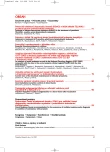Transient hepatitis
Authors:
P. Laššuthová; Z. Petrová; P. Turek
Authors‘ workplace:
Transfúzní oddělení, Fakultní Thomayerova nemocnice, Praha
Published in:
Transfuze Hematol. dnes,14, 2008, No. 2, p. 90-91.
Category:
Comprehensive Reports, Original Papers, Case Reports
Overview
In the paper we present occurence of Hepatitis B surface antigenemia in a blood donor after immunization with first dose of recombinant vaccine Engerix B. Antigenemia was detected by common diagnostic methods. The positive result was on D+2. Control tests on D+16 revealed negative results. The blood donor was not in a risk for Hepatitis B infection. Therefore, we conclude, that the antigenemia occured as a result of vaccination. This paper supports the relevance of the new Guidelines of Society for Transfusion Medicine, where is recommended, that blood donors should defer from donation for one month after vaccination against Hepatitis B.
Key words:
HBsAg, antigenemia, blood donation
Sources
1. Kloster B, Kramer R, Eastlund T, Grossman B, Zarvan B. Hepatitis B surface antigenemia in blood donors following vaccination. Transfusion 1995; 35: 475–477.
2. Seed CR, Lee JF, Maloney R, DiRosso A, Cobain TJ. Hepatitis B surface antigenemia in blood donors after vaccination. Transfusion 1996; 36: 386.
3. Dow BC, Yates P, Galea G, Munro H, Buchanan I, Ferguson K. Hepatitis B vaccinees may be mistaken fo confirmed hepatitis B surface antigen-positive blood donors. Vox Sanguinis 2002; 82: 15–17.
4. www. transfuznispolecnost.cz/doc/postupy.
5. www.redcross.org/services/biomed/0.1082.0 557 00.html.
Labels
Haematology Internal medicine Clinical oncologyArticle was published in
Transfusion and Haematology Today

2008 Issue 2
- Administration of aPCC as a Prevention of Bleeding After Major Cardiac Surgical Procedures
- The Importance of Hydration in Wound Healing
- Cost Effectiveness of FVIII Substitution Versus Non-Factor Therapy for Hemophilia A
- Vascular Disease in the Gradually Aging Population of Hemophiliacs: An Underestimated Problem?
- Prognostic Significance of Subclinical Joint Changes on MRI in Hemophilia
Most read in this issue
- Essential thrombocythaemia in children
- Transient hepatitis
- Good manufacture practice controls in blood banks
- Advances in treatment of Ph-positive adult acute lymphoblastic leukaemia
